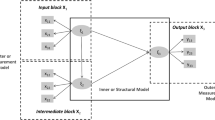Abstract
For binary variables, multivariate positivity of order 2 (MTP2) implies nonnegative partial correlations (NPC). This is so because for any triple of variables, MTP2 is equivalent with conditional association.
Under weak distribution assumptions of the noise variables, monotone higher-order one-factor models imply MTP2 of the manifest variables. This remains true after discretization of the manifest variables. Therefore, MTP2 and NPC cannot be used to discriminate unidimensional monotone latent variable models from multidimensional monotone higher-order one-factor models.
Access this chapter
Tax calculation will be finalised at checkout
Purchases are for personal use only
Similar content being viewed by others
References
Bartolucci F, Forcina A (2005) Likelihood inference on the underlying structure of IRT models. Psychometrika 70:31–43
Chen FF, Sousa KH, West SG (2005) Testing measurement invariance of second-order factor models. Struct Equ Model 12:471–491
Denuit M, Dhaene J, Goovaerts M, Kaas R (2005) Actuarial theory for dependent risks. Wiley, Chichester
De Gooijer JG, Yuan A (2011) Some exact tests for manifest properties of latent trait models. Comput Stat Data Anal 55:34–44
Efron B (1965) Increasing properties of Pólya frequency functions. Ann Math Stat 36:272–279
Ellis JL (2014) An inequality for correlations in unidimensional monotone latent variable models for binary variables. Psychometrika 79:303–316. doi:10.1007/S11336-013-9341-5
Flanagan DP, Fiorello CA, Ortiz SO (2010) Enhancing practice through application of Cattell–Horn–Carroll theory and research: a “third method” approach to specific learning disability identification. Psychol Sch 47:739–760. doi:10.1002/pits
Holland PW (1981) When are item response models consistent with observed data? Psychometrika 46:79–92
Holland PW, Rosenbaum PR (1986) Conditional association and unidimensionality in monotone latent variable models. Ann Stat 14:1523–1543
Junker BW, Ellis JL (1997) A characterization of monotone unidimensional latent variable models. Ann Stat 25:1327–1343
Karlin S, Rinott Y (1980) Classes of orderings of measures and related correlation inequalities, I. Multivariate totally positive distributions. J Multivar Anal 10:467–498
Karlin S, Rinott Y (1983) M-matrices as covariance matrices of multinormal distributions. Linear Algebra Appl 52(53):419–438
Olsson U (1979) Maximum likelihood estimation of the polychoric correlation coefficient. Psychometrika 44:443–460
Raveh A (1985) On the use of the inverse of the correlation matrix in multivariate data analysis. Am Stat 39:39–42
Rinott Y, Scarsini M (2006) Total positivity order and the normal distribution. J Multivar Anal 97:1251–1261
Sardy S, Victoria-Peser M-P (2012) Isotone additive latent variable models. Stat Comput 22:647–659
Whitt W (1982) Multivariate monotone likelihood ratio and uniform conditional stochastic order. J Appl Probab 19:695–701
Yalcin I, Amemiya Y (2001) Nonlinear factor analysis as a statistical method. Stat Sci 16:275–294
Yung Y-F, Thissen D, McLeod LD (1999) On the relationship between the higher-order factor model and the hierarchical factor model. Psychometrika 64:113–128
Author information
Authors and Affiliations
Corresponding author
Editor information
Editors and Affiliations
Rights and permissions
Copyright information
© 2015 Springer International Publishing Switzerland
About this paper
Cite this paper
Ellis, J.L. (2015). MTP2 and Partial Correlations in Monotone Higher-Order Factor Models. In: Millsap, R., Bolt, D., van der Ark, L., Wang, WC. (eds) Quantitative Psychology Research. Springer Proceedings in Mathematics & Statistics, vol 89. Springer, Cham. https://doi.org/10.1007/978-3-319-07503-7_16
Download citation
DOI: https://doi.org/10.1007/978-3-319-07503-7_16
Publisher Name: Springer, Cham
Print ISBN: 978-3-319-07502-0
Online ISBN: 978-3-319-07503-7
eBook Packages: Mathematics and StatisticsMathematics and Statistics (R0)




